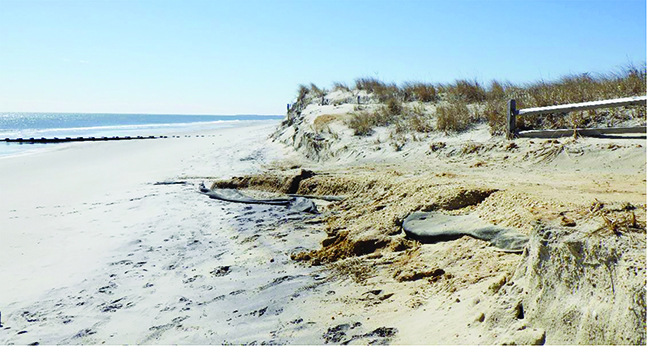Beach erosion slows, but replenishment will be late
‘We’re really asking people to stay off the dunes in that area. It is very unsafe to be up there and unsafe to walk along the sand below. It could sough off the sand face without notice, and whether falling down 10 feet or a 10-foot wall of sand falling on you, it could be dangerous.’
– Township Engineer Paul Dietrich
STRATHMERE — There is good news and bad news for those who love the beach, whether’s its because they enjoy relaxing there or count on it to protect their oceanfront homes.
While the mild winter and early spring spared the beaches and dune system further damage, severe erosion had taken its toll and Upper Township likely will not see a remedy until after the 2023 season wraps up. A delay in the bid process means beach replenishments likely will not get started until late summer.
The Stockton University Coastal Research Center surveyed beaches on the island in March for this year’s first-quarter review.
Its report states the quarter was a bit milder in terms of storms, with minor events including a mid-January non-tropical low pressure system centered over the northwestern Atlantic Ocean off the New Jersey coast.
That storm forced the township to close a fourth beach access point in the north end. The report states the exposed access path crossover suffered damage as the narrow beach provided little wave protection.
The township started limiting access with Seaview Avenue in spring 2022, then closed Seacliff and Winthrop avenues last summer because they became inaccessible on foot.
Williams Avenue was closed in January but, according to township engineer Paul Dietrich, was reopened May 19. He said barring any major storm, it should remain open.
“We will continue to monitor that access through the summer,” Dietrich said.
He said the report “tells the story of what we see with our eyes.” The area continues to experience erosion but not at such an escalated pace as had been seen last fall. However, he said a 6- to 12-foot scarp remains from Williams Avenue north and there is just zero to 20 feet of sand in the area at high tide.
“We’re really asking people to stay off the dunes in that area,” Dietrich said. “It is very unsafe to be up there and unsafe to walk along the sand below. It could sough off the sand face without notice, and whether falling down 10 feet or a 10-foot wall of sand falling on you, it could be dangerous.”
According to the report, sand eroded from the dry beach and was deposited offshore in the bar system. The report said the six beach profiles lost an average total of 16,608 cubic yards of sand from the beach above the zero-elevation point while shedding just 10,962 cubic yards of material from the offshore regions.
“The seasonal loss of 27,526 cubic yards represents minimal changes between the Sea Isle City boundary and 2400 Commonwealth Avenue,” it stated. “Thus far into 2023, there has been additional dune damage documented at the Williams Avenue and Seaview Avenue sites where the seaward dune slope has been scarped.”
The quarterly monitoring sites are First Street at the border with Sea Isle City, 2400 Commonwealth Ave., Jasper Avenue, Tecumseh Avenue, Williams Avenue and Seaview Avenue at Corson’s Inlet.
The report states the combination of wave approach and refraction around the nearby offshore bathymetry of Corson’s Inlet accelerates sand movement from the oceanfront near the inlet into the main channel. The northernmost developed oceanfront is constantly under erosional stress if large offshore sand supplies are not present as a result of inlet processes.
“Winter storm erosion does focus on the beach berm as stronger waves act to carve away the summer deposition and drag it offshore where some moves south toward Sea Isle City or back toward Corson’s Inlet,” the report states.
Perhaps the worst spot is Seaview Avenue near the boundary to Corson’s Inlet State Park. Its location makes it vulnerable to rapid beach changes from inlet dynamics and northeast storms, according to the report.
“To mitigate these losses, the latest federal project created a wide bump out in the beach width. The erosional process at work throughout 2022 rendered what was left of the protective dunes and associated structures at a critical state extremely vulnerable to increased damage,” it states.
“The inlet seawall, installed in 2008 as an emergency municipal effort to protect properties, is now exposed as the inlet waters removed additional sand over the winter.”
The report’s summary states Seaview Avenue “remains at a critically vulnerable state with exposed seawall and a very narrow, low-lying beach.”
The losses this quarter were focused mainly at the Jasper and Tecumseh Avenue sites in the nearshore and offshore regions as well as dune and beachface erosion at the Williams Avenue location.
Dietrich said the U.S. Army Corps of Engineers and state Department of Environmental Protection assessed conditions over the winter before putting the next beach replenishment project out to bid, but the process was delayed and no work is expected until after summer. The project initially was expected to begin in late June but now is more likely in September, he said.
“We have been notified that has been delayed from being awarded,” Dietrich said. “They are anticipating bids in the next week or two and hope to award the bid in August.
“We most likely will not see beachfill before Labor Day,” Dietrich said.
However, the engineer said as the summer starts to approach, beach conditions will generally improve as winds shift south to southeast and the beach may start to grow — but only if there is no major storm.
He said the Upper Township Beach Patrol is planning adjustments to its operations since both vehicle and foot traffic will be limited in the north end, where most of the homes are located.
“They’re anticipating more activity, more concentration on the south end between Randolph Avenue and Whale Beach, but because the north end has a wide beach at low tide, they are evaluating how to patrol and guard the north end beaches,” Dietrich said.
Strathmere is part of the southern Ocean City and Sea Isle City beach replenishment project.
According to the U.S. Army Corps of Engineers website, the Great Egg Harbor Inlet to Townsends Inlet project first received funding in 2013 when Congress enacted the Disaster Relief Appropriations Act following Hurricane Sandy.
In November 2014, the Army Corps awarded a $57.6 million contract to the Great Lakes Dredge and Dock Co. to complete the coastal storm damage reduction project from the southern end of Ocean City to Strathmere and Sea Isle.
The project, which entailed the construction of a dune and beach is a joint effort of the Army Corps’ Philadelphia District and the DEP. The initial construction project was completed in spring 2016. The project is eligible for periodic nourishment on a five-year cycle pending adequate funding.
Dietrich said the Strathmere last got sand in fall 2019 and it took one to two months to complete.
By CRAIG D. SCHENCK/Sentinel staff


